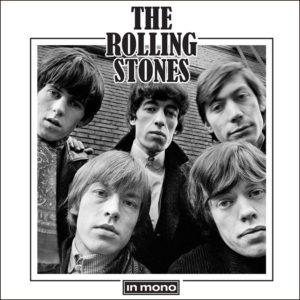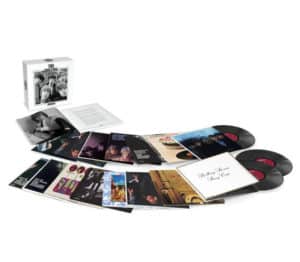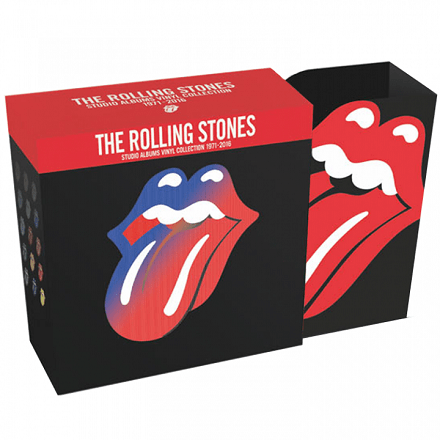Marketplace
2016 Abkco PRESSING
- Audio Mono
- Catalog Number 18771834519
- Release Year 2016
- Vinyl Mastering Engineer Robert Ludwig, Alex Wharton & Sean Magee
- Pressing Weight 180g
- # of Disks 16
- Vinyl Color No
- Box Set Yes
- Jacket Style Other
Mono was King (Queen and Jack) in 1964 when the Rolling Stones started recording as a rhythm and blues cover band. How else do you play back recordings of Bo Diddley and Chuck Berry? It’s a sound unto itself, a sound that would have just been plain wrong in stereo. As manager/producer Andrew Long Oldham wrote in the cover note for the band’s first LP, the Stones’ “public buys sound, and the sound is what they give you.” Whether the public was clambering for the sound of Chess Records, or whether the Stones created that demand can be debated, but one thing remains clear: The Stones were the first to market the sound to a truly huge audience. And what you get in this 2016 box set is 16 slabs of mono vinyl of the Stones’ first five years, which can be broken down into four periods.
The first era can be a bit confusing, as it includes reissues of both the early U.K. and U.S. albums. These 1964 albums—The Rolling Stones (U.K.), 12 X 5 (U.S.), The Rolling Stones No. 2 (U.K.),and The Rolling Stones, Now!(U.S.)—are mostly comprised of covers. The tracks (many of which overlap on the U.S. and U.K. editions) were recorded at Regent Sound Studios in London, Chess Studios in Chicago, and RCA Studio in Hollywood.
Like many who heard them, the Stones helped ignite my long fascination with the blues—and the collecting of blues records. I agree with Mick Jagger’s oft-quoted line, “What’s the point in listening to us doing ‘I’m A King Bee’ when you can listen to Slim Harpo doing it?” The group’s earliest albums from 1964 and 1965 feature some awesome material, but the best (and least-derivative) fare got distilled into greatest-hits packages like Decca’s Big Hits (High Tide and Green Grass)—exactly where I would gravitate for early Stones. That’s not to say the early albums are not outstanding LPs. But judged by what follows, they seem a little dated. The Stones were cranking out mega hits like “Satisfaction,” “Get Off of My Cloud,” and “Time Is on My Side,”but the albums are top-heavy with covers.
Next up in the set are the albums that prove Jagger and Richards’ development as writers—both U.S. and U.K. versions of Out of Our Heads and Aftermath, as well as December’s Children (a U.S.-only release). Save for Aftermath, these again are comprised of a grab bag of tracks laid down in London, Chicago, and Hollywood. Aftermath sees the band settle in at the RCA Studio for the complete session. Made two years into its existence as a recording band, Aftermath shows the Stones on a new level. They deliver a set of all-original compositions, material that defined their persona forevermore. The swagger and misogyny, traits not unknown in traditional blues, take on a very white-boy flavor that would become a Stones (and especially a Jagger) trademark. They even stray (very successfully) into psychedelia with a sitar on “Paint It Black.”
The third group of records stems from the Summer of Love (1967)—Between the Buttons, the “hits” package Flowers,and Their Satanic Majesties Request. For the Stones, the year was a bit of a letdown. While Between the Buttons is not bad, per se, when it’s compared to what the Stones achieved between 1968 and 1972, the word “between” serves as a good title choice since the record arrived between some truly superior releases. The U.S. version includes “Ruby Tuesday” and “Let’s Spend the Night Together,” while the U.K. edition follows British protocol and leaves those hits off the album. The two hits were instead assembled with favorites from Aftermath and other hit singles to form Flowers. The Stones closed 1967 with Their Satanic Majesties Request, an attempt to compete with the Beatles’ Sgt. Pepper’s Lonely Hearts Club Band. I didn’t like it in 1967, and putting a mono skirt on the beast hasn’t changed my opinion.
Once free of 1967, the Stones’ output over the next several years remains beyond compare. The Beatles were winding down, but the Stones were just hitting their stride. The mono box set picks up the first two of the Stones transcendent masterpieces—Beggars Banquet and Let It Bleed. However, these two LPs were stereo recordings (except for the single “Sympathy For The Devil”) and not released in mono. Like Blue Note recordings made after October of 1958, the mono versions included in this set are folded down from the stereo recordings. The box’s liner notes state the two LPs are present, despite their lack of mono pedigree, because “fan demand required us to include them.” Or just maybe, the addition of these two titles to the 2018 Rolling Stones box set The Studio Albums Vinyl Collection 1971-2016 would have made it too heavy.
My initial foray into The Rolling Stones in Mono came via the companion CD box set, whose sound is so dreadful, thin, and dynamically lacking that I initially shied away from the vinyl counterpart. Would the latter be as horrid as the CD edition, or would it be a quality product like the The Beatles in Mono analog set—a very nice package, although in most instances, I prefer the originals to the reissues. As those thoughts swirled in my head, I reluctantly queued up a few of the Stones mono LPs and couldn’t believe what I heard.
Unlike the CDs, the analog mono masterings sound fantastic across the board. The bass and dynamics, somewhat stripped from the originals to accommodate early playback systems, is restored. The biggest change shows on the early LPs, which sounded emasculated compared to the best blues recordings of the 1950s and 1960s. Listen to a black-label original of The Best Of Muddy Waters on Chess, or better yet, Lightnin’ and the Blues on Herald, and you hear that recording engineers knew how to record gut-punching bass and dynamics before the Stones came along. Such punch and immediacy has been restored by Restoration Producer Teri Landi and his team; Bob Ludwig of Gateway Mastering; and lacquer cutting at Abbey Road Studios with Sean Magee and Alex Wharton. The Rolling Stones in Mono is sourced from the original analog tapes, which were restored and then transferred to DSD from which the lacquers were cut.
Despite the fact the Stones recorded at numerous locations and with a variety of recording teams, the results of the new restoration are uniform throughout the entire mono series, with the advantages falling off with the two fold-down mono albums. With Beggars Banquet, the reissue trumps a U.K. “wide band” original when it comes to tighter bass, with better-defined low-frequency punch in the piano’s lower register and in the percussion. Additionally, the mono presentation of Beggars Banquet seems more realistic than the somewhat artificial stereo image in the original. The biggest enhancement on most of these reissues is that they let you turn up the volume much higher than on an original without any fear of distortion kicking in. Let It Bleed stands the sole odd man out. The very modest increase in bass definition and dynamics of the mono reissue fails to offset the really fine stereo soundstage of the original. I like it both ways, but if push came to shove, I’d stick with the stereo original.
Is it all peaches and cream? Well, not quite. The packaging feels a bit second-rate. Compared to that on The Beatles in Mono, the Stones’ white cardboard box looks like ABKCO bean counters trimmed the budget. Where the Beatles collection features “box within a box” double construction, the Stones box is single-layer. The opening flap on the latter also proves cumbersome and serves no functional purpose, save for making the box unwieldy. And the artwork and construction of the record sleeves are bargain-basement compared to the excellent sleeves used in the Beatles box. The lined paper sleeves claim a slightly tight fit, too, and about half of them on my set were apparently mashed and wrinkled during assembly. No attempt is made to replicate the original record labels.
However, the pressings are immaculate, flat, and quiet. At the end of the day, that’s what counts. As a result, The Rolling Stones in Mono should make a lot of people ecstatic.
The Rolling Stones in Mono



 4
4
